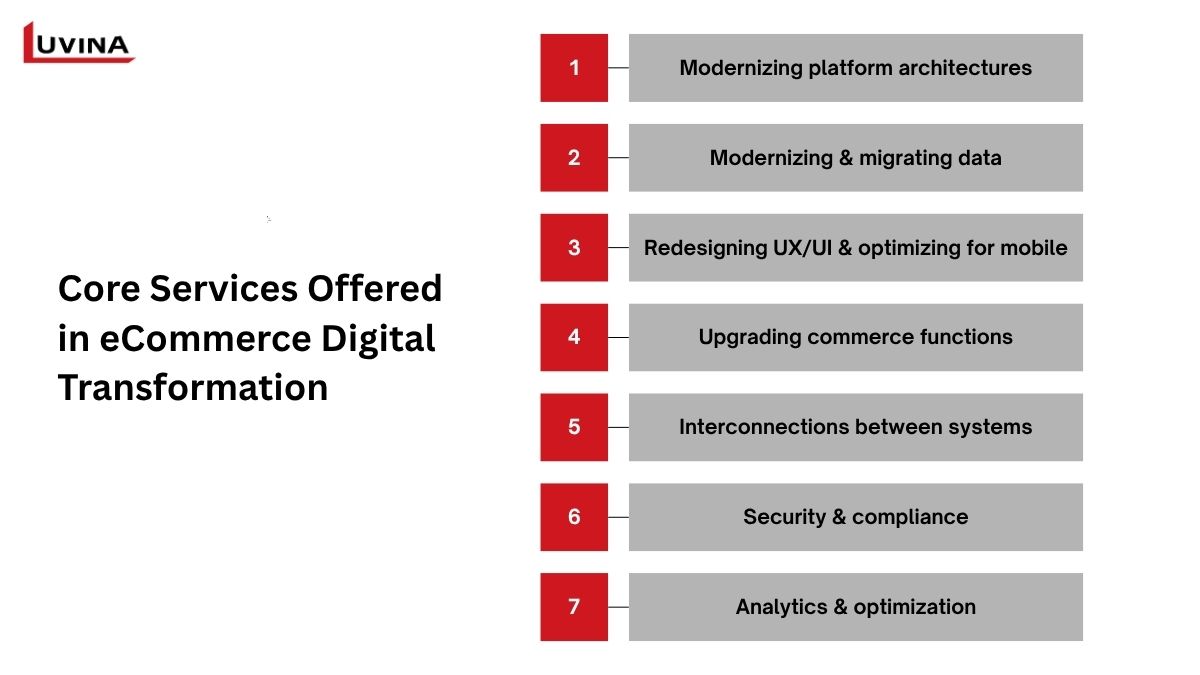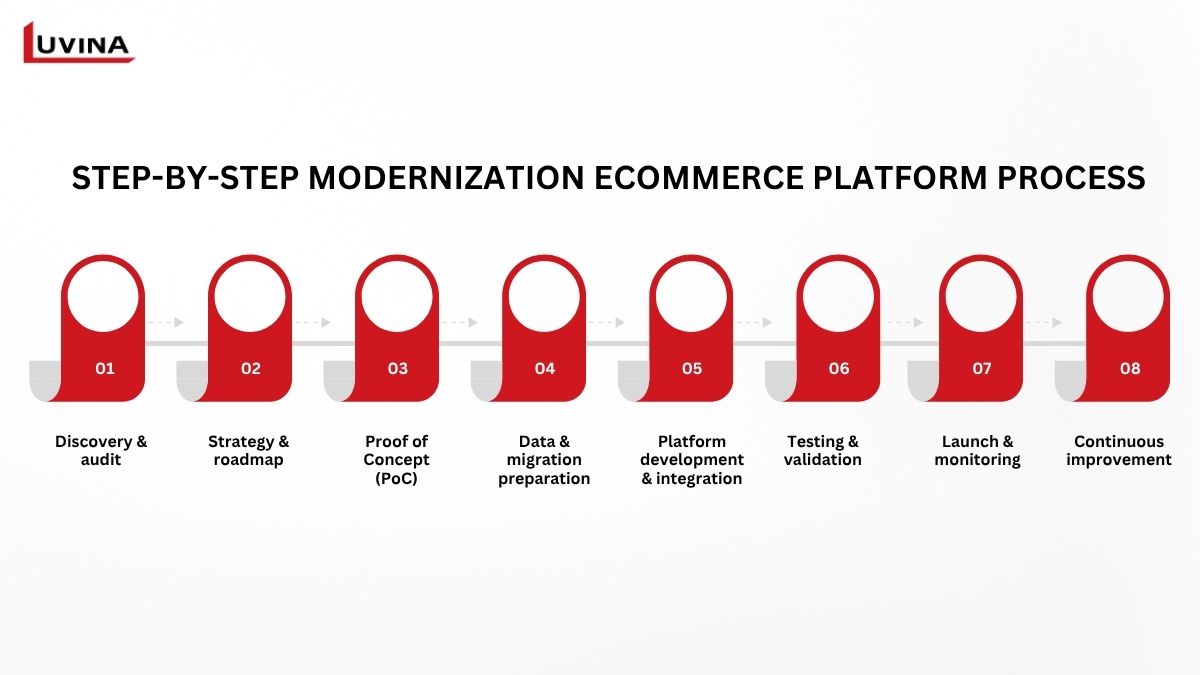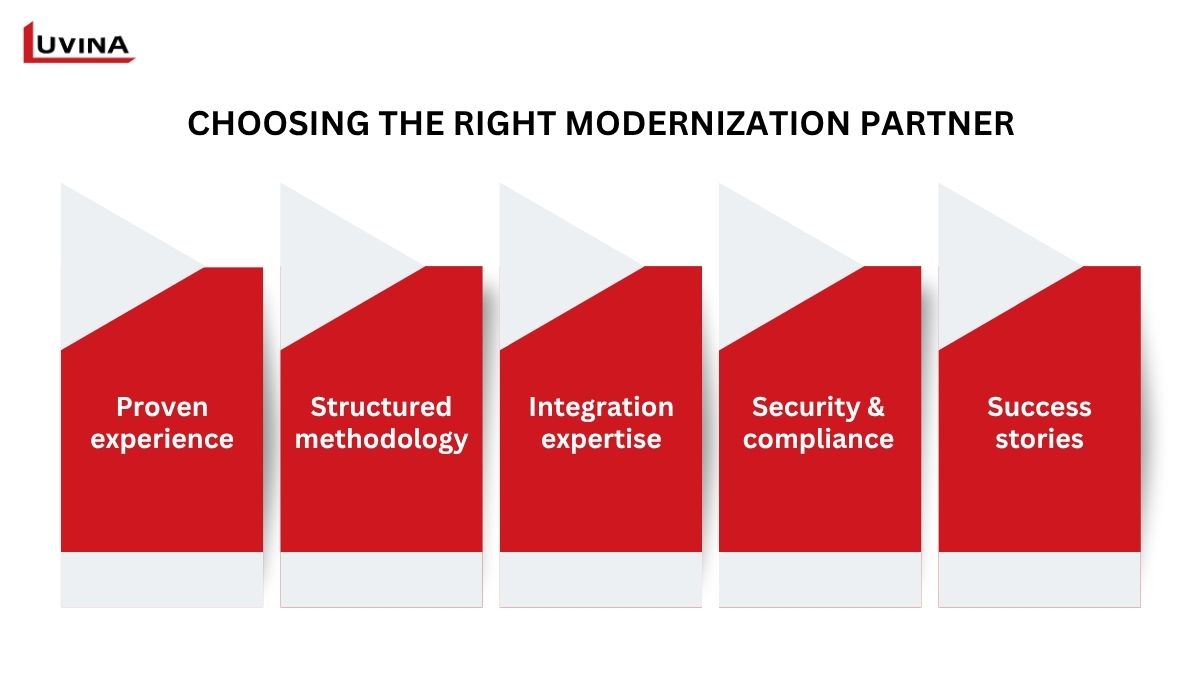Have you ever pondered what forces a booming internet enterprise apart from the “Add to Cart” button? Imagine your e-commerce company as a ship sailing a huge, always-changing digital ocean. Ecommerce digital transformation services will enable companies not only to adjust but also totally rethink how they run, engage with clients, and scale for the future when standing still is not an option.
This article will investigate how forward-thinking companies can use these tools to progressively update their platforms, to avoid expensive errors and unleash discernible commercial impact.
Why Digital Transformation Matters in eCommerce
Businesses that hold on to antiquated systems run the danger of falling behind nowadays. But what precisely does digital transformation mean in this setting? It is the deliberate move from legacy, hand processes to contemporary, linked technology that changes every customer interaction. The core of this development is ecommerce digital transformation services that enable companies to rethink how they sell, serve, and grow in a digital-first environment.
A legacy system modernization for ecommerce is just as important. Many businesses are running on archaic ecommerce platforms that slow down deliverables, do not allow for integration, and/or do not allow for innovation. By modernizing their systems, businesses are enabled to multichannel sell, leverage real-time reporting, and provide customer experiences powered by AI – things customers now expect.
When done correctly, digital transformation brings more than just new tools. It also builds resilience, increases agility, and supports long-term growth. That’s what retailers and e-commerce businesses were adopting when they were transforming – it provided them a competitive advantage: allowing them to quickly turn on new channels, customize at scale, and course correct to (sometimes erratically) changing consumer needs.
Core Services Offered in eCommerce Digital Transformation
Ecommerce digital transformation services are broad in what’s considered digital transformation for ecommerce, i.e., to modernize, simplify, and future-proof everything you do online. Generally, a complete offering includes the following:

- Modernizing platform architectures: Modernize platform architectures by moving away from monolithic systems to flexible microservices, API-first or headless architectures, which allow for lower operating costs and faster upgrades.
- Modernizing & migrating data: Moving consumer data, product data, order data and inventory data securely while protecting data integrity in all systems depends on modernizing and migrating this data to third-party systems.
- Redesigning UX/UI & optimizing for mobile: Design your storefront based on responsive, mobile-first principles to ensure that wherever consumers transact, they receive perfect experiences on any device with your new UX/UI redesign and mobile optimization.
- Upgrading commerce functions: Among the commerce functions you’ll upgrade, you will include advanced features like personalization engines, artificial intelligence chatbots, flexible payment options, and real-time inventory capabilities.
- Interconnections between systems: Connect all critical systems (ERP, CRM, WMS, OMS, payment systems) into one ecosystem integration that works in the way you do
- Security & compliance: Digital transformation efforts will lead to modern authentication with the proper security requirements, including PCI DSS and GDPR for your customers and your business.
- Analytics & optimization: Derive insights and turn them into quantifiable growth from GA4, A/B testing and ongoing performance assessment.
>> Also read: Why CRM Integration is the Ultimate Growth Lever for eCommerce
Step-by-Step Modernization eCommerce Platform Process
Knowing the patterns is only the beginning. Bringing them to life calls for a clear, practical road map. Correct ecommerce digital transformation services help you through every step of this process, guaranteeing your modernization initiatives are organized, practical, and successful. Let’s begin with these crucial phases:

- Discovery & audit
Every effective change starts with a close look at your present situation. This stage includes auditing your current tech stack, finding dependencies between systems, and finding bottlenecks limiting growth. By examining your present workflows, integrations, and pain points, you obtain a thorough knowledge of what needs changing and provide a strong basis for the phases to follow.
- Strategy & roadmap
A good strategy guarantees that your ecommerce digital transformation services fit business objectives, consumer expectations, and long-run growth plans.
Realistic timelines, an appropriate digital strategy for modernization, and specific objectives all define this phase. By developing a clear, actionable plan, we will be positioning your ecommerce business to put in place a transformation that optimizes efficiency, limits risk, and maximizes sustainable value.
- Proof of Concept (PoC)
It is imperative to try your concepts in a controlled environment before totally investing in a major deployment. With little risk, a well-done PoC verifies your selected modernization strategy and architecture. You could, for instance, construct a single element or customer journey using fresh tools and processes to assess actual-world influence.
Particularly for legacy system modernization for ecommerce, this step is crucial as it reveals early on unseen problems, integration difficulties, and performance deficits.
- Data & migration preparation
Any successful change depends on data. But transferring it is not only moving files from point A to point B. At this point, companies concentrating on ecommerce legacy modernization have to back up all important data, map relationships across systems, and delete outmoded or duplicate information. This painstaking groundwork guarantees that during migration, client, product, and order information remain correct and intact.
- Platform development & integration
It’s now time to realize your fresh vision with a clear dataset and a strong strategy in place. From creating an appealing, user-friendly UX/UI to merging all crucial systems, the ecommerce digital transformation services here provide genuine results.
Developers concentrate during this phase on developing mobile-first, responsive interfaces that enhance the shopping experience. Simultaneously, backend teams merge your ERP, CRM, payment gateways, and other vital tools into one unified environment.
- Testing & validation
Every element of your updated e-commerce platform must be thoroughly tested before going live to guarantee it runs perfectly in actual circumstances.
- Functional testing verifies that every function performs as anticipated across several browsers and devices.
- Performance testing assesses how effectively the system responds to stress and load under peak traffic.
- Security checks guarantee complete protection of sensitive customer information and transactions.
- Before launch, user acceptance testing (UAT) lets actual consumers experience your platform to verify the general impression.
At this point, thorough testing lowers risk, fosters trust, and guarantees your digital transformation produces results starting from day one.
- Launch & monitoring
The ultimate phase converts all of your preparation into a quantifiable commercial result. Reducing disturbance and providing a flawless customer experience starting day one depends on a smooth golive strategy. Clear KPIs are set during this stage of ecommerce digital transformation to monitor performance, user engagement, and system stability in real time.
- Continuous improvement
The modernization journey doesn’t end at launch. It is an ongoing process. To modernize ecommerce legacy systems, you must create a culture of ongoing optimization within your business, throughout the entire customer experience.
This step requires you to understand your platform’s performance, how consumers are engaging with it, and where friction points exist. Utilizing analytics and real-time data to be able to adapt will allow the majority of ecommerce platforms to improve the ongoing experience of the consumer.
There is no modernized commerce experience without testing and feedback from consumers, so feature performance can be optimized, so together you can meet shifting consumer expectations, work on practical ways to enhance your competitive position and ensure that your ecommerce business adopts and evolves with market requirements.
Business Impact & Quantifiable Benefits
Investing in e-commerce digital transformation services will create clear, long-lasting value for your company. Businesses that accept change often show better customer involvement, greater agility in volatile markets, and more income.
Speedier checkouts and personalized product recommendations are just the beginning. Nearly 55% of companies report that modernization directly improves the customer experience. Also driving results: mobile-first design, a key product of legacy system modernization for ecommerce, increases conversion rates on responsive, optimized platforms, with more than 70% of e-commerce traffic now originating from mobile devices.
Also, the use of AI-based customization will increase conversion rates by 20–30%, turning real-time consumer insight into customized experiences that build loyalty and repeat purchases. With the switch from hinge systems to pliable microservices, companies can accelerate development cycles, deliver features faster, and grow without interruption.
When done right, all of the digital transformation can deliver clear, quantifiable benefits that can strengthen every part of your ecommerce business today, and well into the future.
Choosing the Right Modernization Partner
The correct team to provide ecommerce digital transformation services may distinguish between a seamless, scalable change and expensive setbacks. Choosing a partner shouldn’t be left to chance; it calls for a clear checklist with innovative technologies, system integrations, and security requirements to take into account. Good providers of e-commerce digital transformation services combine technical expertise, verified outcomes, and a flexible, cooperative strategy that fits your objectives.
When assessing possible partners, search for the following:

- Proven experience: Strong record in legacy migrations and ecommerce projects, complete with pertinent case studies and measurable results.
- Structured methodology: A structured methodology means a clear plan with a step-by-step process, a complete audit, thorough testing phases, and a well-documented rollback plan if there are any issues during transition.
- Integration expertise: Integration expertise means a thorough understanding of integrating cloud infrastructure, payments gateways, ERP, and CRM to ensure both telemetry and frictionless operations from end to end.
>> Also read: E-commerce Payment Gateway Integration: Complete Guide
- Security & compliance: Security & compliance means having the certifications and commitment to data privacy standards, anytime there are standards like PCI DSS and GDPR and a proactive approach to cybersecurity.
- Success stories: Success stories mean presenting real-world outcomes in a portfolio and client recommendations and engagement in long-term partnerships.
Conclusion
There’s no denying it – the digital era has redefined how we shop, connect, and grow. For ecommerce brands, this means moving beyond patchwork fixes and embracing true, future-ready change with ecommerce digital transformation services.
Naturally, many transformations are not easy. But you do not have to do it alone. At Luvina, we bring technical skills, standardized processes and our team of dedicated people to help you work through all aspects of your modernization journey.
Want to start your eCommerce transformation now? Request a personalized quote, tailored to your systems.
Read more:









Read More From Us?
Sign up for our newsletter
Read More From Us?
Sign up for our newsletter